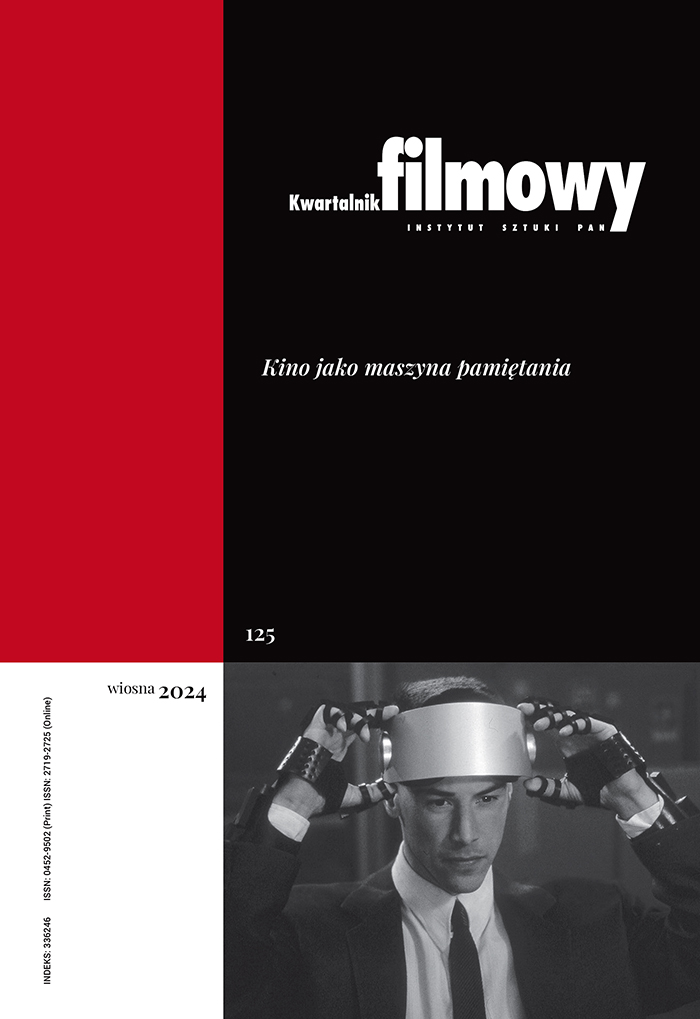„Dokument”, „We Have One Heart”, „Papa”. Zagubieni ojcowie, dokument, animacja i autobiografia
Agnieszka Powierska
agnieszka.powierska@gmail.comPaństwowa Uczelnia Zawodowa we Włocławku (Polska)
https://orcid.org/0000-0003-3879-9033
Abstrakt
Tematem artykułu są trzy krótkometrażowe filmy z pogranicza dokumentu i animacji, zrealizowane przez twórców młodego pokolenia: Dokument Marcina Podolca (2015), We Have One Heart Katarzyny Warzechy (2020) i Papa Maryi Yakimovich (2020). Opowiadają one historie złożonych relacji między dzieckiem a ojcem. Autorka powołuje się na opracowania Anabelle Honess Roe oraz polskie próby konceptualizacji dokumentu animowanego, proponuje też definicję formuły nawiązującą m.in. do kategorii paktu referencjalnego Philippe’a Lejeune’a. Autorka przeprowadza formalistyczną analizę filmów, badając zbieżności między nimi. W nawiązaniu do uwag Katarzyny Mąki-Malatyńskiej i Michała Piepiórki na temat znaczeń materiałów faktualnych w dokumentach animowanych, przygląda się sposobom użycia rodzinnych pamiątek w analizowanych utworach; następnie omawia wykorzystanie w nich konwencji autobiograficznych. Siła oddziaływania tych filmów wynika z połączenia konwencji dokumentalnych, perspektywy subiektywnej i kreacyjnych rozwiązań formalnych.
Słowa kluczowe:
animacja, dokument, dokument animowany, animadok, fotografiaBibliografia
Altman, R. (2012). Gatunki filmowe (tłum. M. Zawadzka). Warszawa: Wydawnictwo Naukowe PWN.
Google Scholar
Chrobak, D. (2009). Sukces kwadratury koła. Dwutygodnik.com. https://www.dwutygodnik.com/artykul/82-sukceskwadratury-kola.html
Google Scholar
Czapliński, P. (2019). Gatunek orientacyjny. Reportaż polski na przełomie XX i XXI wieku. Teksty Drugie, (6), ss. 19-41. https://doi.org/10.18318/td.2019.6.2
Google Scholar
Driessen, K. (2007, 18 listopada). Animated documentaries. IDFA. https://www.idfa.nl/en/article/65671/animatiedocumentaires
Google Scholar
Giżycki, M. (2018). Animowany dokument. Nowy gatunek czy chwyt marketingowy?. Kwartalnik Filmowy, (101-102), ss. 300-306.
Google Scholar
Haratyk, P., Sitek, G. (2018). „Found footage” jako kino odnowy znaczenia „home movies” w filmach „A Song of Air” i „Sea In The Blood”. Kwartalnik Filmowy, (104), ss. 178-192.
Google Scholar
Hendrykowski, M. (2017). Animacja jako dokument. Dokument jako animacja. Wokół poetyki i antropologii ruchomych obrazów. W: M. Kozubek, T. Szczepański (red.), Polska animacja w XXI wieku (wyd. 1, ss. 105-137), Łódź: Wydawnictwo Biblioteki PWSFTviT.
Google Scholar
Hirsch, M. (2011). Pokolenie postpamięci (tłum. M. Borowski, M. Sugiera). Didaskalia, (105), ss. 28-36.
Google Scholar
Honess Roe, A. (2013). Animated documentary. Basingstoke – New York: Palgrave Macmillan.
Google Scholar
Honess Roe, A. (2013). Nieobecność, nadmiar i rozwinięcie epistemologiczne: w poszukiwaniu ram badawczych dla dokumentu animowanego. Panoptikum, 12, ss. 27-45.
Google Scholar
Jazdon, M., Mąka-Malatyńska, K. (2011). Wstęp. W: M. Jazdon, K. Mąka-Malatyńska (red.), Zobaczyć siebie: polski film dokumentalny przełomu wieków (wyd. 1, ss. 5-7). Poznań: Centrum Kultury Zamek.
Google Scholar
Koschany, R. (2017). Co to jest dokument i czy pytanie to ma jakiekolwiek znaczenie? (Na marginesie „Pięciu nieczystych zagrań” Larsa von Triera i Jørgena Letha). Images. The International Journal of European Film, Performing Arts and Audiovisual Communication, 21 (30), ss. 5-15.
Google Scholar
Kozubek, M. (2007). (Auto)terapeutyczny wymiar „rodzinnych” filmów Marcina Koszałki. Kwartalnik Filmowy, (73), ss. 53-62.
Google Scholar
Kurz, I. (2009). Wściekłe psy pamięci. Dwutygodnik.com. https://www.dwutygodnik.com/artykul/15-wsciekle-psypamieci.html
Google Scholar
Lejeune, P. (1975). Pakt autobiograficzny. Teksty, 5, ss. 31-49.
Google Scholar
Łaguna-Raszkiewicz, K. (2016). Fotografia rodzinna jako źródło postpamięci. Pedagogika Społeczna, 1 (59), ss. 155-164.
Google Scholar
Mąka-Malatyńska, K. (2005). Nowa szkoła polskiego dokumentu. Rozmowa z Marcelem Łozińskim. W: M. Hendrykowka (red.), Klucze do rzeczywistości. Szkice i rozmowy o polskim filmie dokumentalnym po roku 1989 (ss. 207-215). Poznań: Wydawnictwo Naukowe UAM.
Google Scholar
Mąka-Malatyńska, K. (2017). Wyprawa do krainy prawdopodobieństwa – o dokumentach animowanych Marcina Podolca. Images. The International Journal of European Film, Performing Arts and Audiovisual Communication, 20 (29), ss. 289-300.
Google Scholar
Mąka-Malatyńska, K. (2017). Żart, impresja, dokument. Animacje z Łódzkiej Szkoły Filmowej po 2000 roku. W: M. Kozubek, T. Szczepański (red.), Polska animacja w XXI wieku (ss. 105-137). Łódź: Wydawnictwo Biblioteki PWSFTviT.
Google Scholar
Piechota, G., Wójcik, J. (red.) (2008). List do ojca. Warszawa: Agora SA.
Google Scholar
Piepiórka, M. (2017). „Droga na drugą stronę”: od kino-oka do kina-pędzla i jeszcze dalej. W: M. Kozubek, T. Szczepański (red.), Polska animacja w XXI wieku (ss. 105-137). Łódź: Wydawnictwo Biblioteki PWSFTviT.
Google Scholar
Podolec, M. (2017). Animacja w filmie dokumentalnym. W: K. Mąka-Malatyńska (red.), Od obserwacji do animacji. Autorzy o kinie dokumentalnym (ss. 137-159). Łódź: Wydawnictwo Biblioteki PWSFTviT.
Google Scholar
Przylipiak, M. (2004). Poetyka kina dokumentalnego (wyd. 2 rozsz. i popr.). Gdańsk-Słupsk: Wydawnictwo Uniwersytetu Gdańskiego.
Google Scholar
Pstrągowski T. (2016, 29 lipca). Wzruszająca nagość. WP. https://ksiazki.wp.pl/wzruszajaca-nagosc-6145960260147329a?c=96&nil=&src01=6a4c8.
Google Scholar
Sitkiewicz, P. (2009). Małe wielkie kino. Film animowany od narodzin do końca okresu klasycznego. Gdańsk: słowo/obraz terytoria.
Google Scholar
Tabaszewska, J. (2019). Forma i fakt. Wyzwania współczesnego reportażu. Teksty Drugie, 6, ss. 9-18. https://doi.org/10.18318/td.2019.6.1
Google Scholar
Tabaszewska, J. (2019). Na granicy faktu. Kategoria faction w badaniach nad współczesnymi biografiami. Teksty Drugie, (1), ss. 61-79. https://doi.org/10.18318/td.2019.1.5
DOI: https://doi.org/10.18318/td.2019.1.5
Google Scholar
Trzebiński, J. (2002). Narracyjne konstruowanie rzeczywistości. W: J. Trzebiński (red.), Narracja jako sposób rozumienia świata (ss. 17-42). Gdańsk: Gdańskie Wydawnictwo Psychologiczne.
Google Scholar
Zajas, P. (2009). O naturze pośledniego owada. Nowa propozycja badań nad literaturą. Teksty Drugie, (5), ss. 40-55.
Google Scholar
Autorzy
Agnieszka Powierskaagnieszka.powierska@gmail.com
Państwowa Uczelnia Zawodowa we Włocławku Polska
https://orcid.org/0000-0003-3879-9033
Absolwentka filmoznawstwa i historii sztuki na Uniwersytecie im. Adama Mickiewicza w Poznaniu, edukatorka filmowa, wykładowczyni akademicka. W 2019 r. obroniła pracę doktorską Dokument animowany/animacja dokumentalna – poszerzanie granic filmowych narracji niefikcjonalnych.
Statystyki
Abstract views: 714PDF downloads: 573
Licencja
Prawa autorskie (c) 2020 Agnieszka Powierska

Utwór dostępny jest na licencji Creative Commons Uznanie autorstwa – Użycie niekomercyjne – Bez utworów zależnych 4.0 Międzynarodowe.
Autor bądź autorka udziela wydawcy niewyłącznej i nieodpłatnej licencji (CC BY 4.0) na wykorzystanie tekstu w „Kwartalniku Filmowym”, zachowuje nieograniczone prawa autorskie i zobowiązuje się do podawania miejsca pierwodruku przy ponownym wykorzystaniu artykułu (umowa licencyjna do pobrania). Czasopismo jest wydawane na licencji CC BY 4.0. Zgłaszając artykuł do publikacji, autor bądź autorka wyraża zgodę na jego udostępnianie na tej licencji.
W wydaniach od 105-106 (2019) do 119 (2022) wszystkie artykuły były publikowane na licencji CC BY-NC-ND 4.0. W tym okresie autorzy i autorki udzielali(-ły) niewyłącznej i nieodpłatnej licencji (CC BY-ND 4.0) na wykorzystanie tekstu w „Kwartalniku Filmowym”, zachowywali(-ły) nieograniczone prawa autorskie i zobowiązywali(-ły) się do podawania miejsca pierwodruku przy ponownym wykorzystaniu artykułu.











